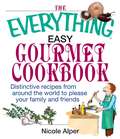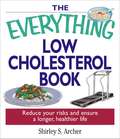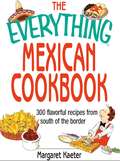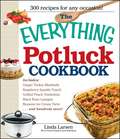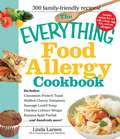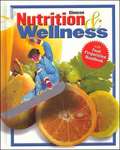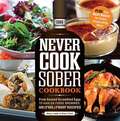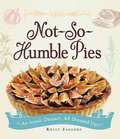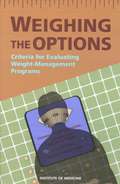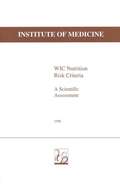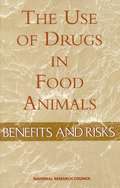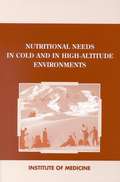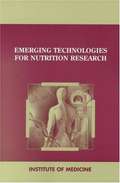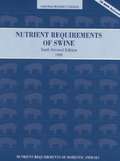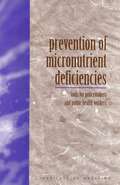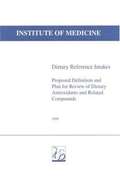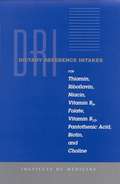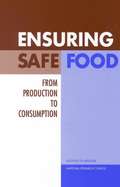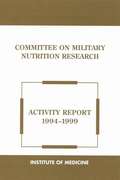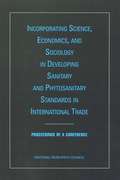- Table View
- List View
THE EVERYTHING® Easy Gourmet COOKBOOK
by Nicole AlperPacked with more than 250 tantalizing recipes from continents near and far, this cookbook satisfies even the most cosmopolitan of cravings with inspired meals created quickly and effortlessly.
The Everything® Low Cholesterol Book
by Shirley ArcherEach year in America, more than one million people suffer from heart attacks caused by high cholesterol-and half a million die from related heart disease. The Everything Low Cholesterol Book provides everything from information on how to create a sensible diet and fitness plan to practical tips for improving your overall well-being. Also included are more than seventy-five heart-healthy recipes for the whole family!
The Everything® Mexican Cookbook
by Margaret KaeterThe Everything? Mexican Cookbook guarantees that you won't have to head out in the middle of the night ever again: you can make your favorite authentic Mexican cuisine right in your own kitchen. The Everything? Mexican Cookbook guides you step by step through creating hundreds of traditional and exotic Mexican recipes. From basic Mexican flavors and ingredients (hot chili peppers) to regional cuisine (Mayan Potatoes with Spicy Beef), The Everything? Mexican Cookbook offers a diverse set of recipes perfect for both vegetarians and meat-eaters alike. Featuring delicious recipes for: Unique salsas, such as Pineapple, Mango, and Cucumber Salsa Bean favorites, such as Refried Beans Spicy breads, such as Jalape'o Corn Bread Traditional favorites, such as Chili con Queso Tempting desserts, such as Mexican Wedding Cake Whether you want to prepare a feast for one or plan a fiesta for friends, The Everything? Mexican Cookbook will have you shouting "Ol?!" in no time!
The Everything® Potluck CookBook
by Linda LarsenPotlucks are a great way to get friends and relatives together without the pricey grocery or restaurant bill! In this cookbook, veteran cook Linda Larsen gives you an array of options for every meal and course. In addition, easy-to-understand icons indicate whether a recipe is easy, healthy, quick, or inexpensive. Everything you need to host, or attend, a successful potluck is here, including: 300 tasty and creative recipes Tips for transporting food safely Indications of whether a recipe can be made ahead of time Menu suggestions for a variety of potluck parties Guests can make the dishes on their own and bring them to the host's home, or they can all gather in the host's kitchen and make them together. With this book, cooking for the perfect potluck party has never been easier!
The Everything Guide to Being Vegetarian
by Alexandra GreeleyWith nearly 6 million adult vegetarians in the United States, a push toward a leaner, greener, healthier lifestyle is happening everywhere. Whether their reasons are moral, economic, or health-related, people all over the country'and the world'are making the switch to vegetarianism. In this book, you discover: Easy ways to get essential nutrition like protein and iron Where to buy fresh, high-quality produce without breaking the bank Cooking tips and techniques for a vegetarian kitchen, such as how to prepare tofu Delicious vegetarian recipes for every meal of the day, including choices kids will love The real difference between vegetarian and vegan A vegetarian lifestyle doesn't have to be restrictive; with the help of this book it can be liberating and satisfying! The key is the right information and recipes so you can say goodbye to meat and hello to a fresh, new life.
The Everything Food Allergy Cookbook
by Linda LarsenFood allergies in the United States are growing at an alarming rate and, unfortunately, children are often afflicted with more than one allergy. For the families, preparing a meal can be unnerving. This cookbook takes the guesswork out of shopping and cooking delicious meals everyone will enjoy. There's no missing out with such tasty delights as: NoNut Crunchy Coffee Cake Eggless French Toast DairyFree Risotto Curry No Soy Pork and Veggie Stir Fry Wheat and DairyFree Chocolate Chip Cookies and more! Each recipe is labeled to indicate which allergies are safe so readers can mix and match according to their family's needs. Packed with tips and tools for reading labels and purchasing ingredients, the entire family can finally eat great tasting foods without the danger of an allergic reaction.
Paris, My Sweet
by Amy ThomasUpcoming Events for Paris, My SweetBosie Tea Party (New York, NY) – February 16thThree Tarts (New York, NY) – March 8th Public Library Association (Philadelphia, PA) – March 16thBooks Inc. (San Francisco, CA) – March 22ndFog City News(San Francisco, CA)– March 23rd"From the New York cupcake wars to the perfect Parisian macaron, Thomas's passion is palpable, her sweet tooth, unstoppable. "—Elizabeth Bard, bestselling author of Lunch in ParisForever a girl obsessed with all things French, sweet freak Amy Thomas landed a gig as rich as the purest dark chocolate: leave Manhattan for Paris to write ad copy for Louis Vuitton. Working on the Champs-Élysées, strolling the charming streets, and exploring the best patisseries and boulangeries, Amy marveled at the magnificence of the City of Light. But does falling in love with one city mean turning your back on another? As much as Amy adored Paris, there was part of her that felt like a humble chocolate chip cookie in a sea of pristine macarons. PARIS, MY SWEET explores how the search for happiness can be as fleeting as a salted caramel souffle's rise, as intensely satisfying as molten chocolate cake, and about how the life you're meant to live doesn't always taste like the one you envisioned. Part love letter to Paris, part love letter to New York, and total devotion to all things sweet,PARIS, MY SWEETis a treasure map for anyone with a hunger for life. "Like a tasty Parisian bonbon, this book is filled with sweet surprises. "—David Lebovitz, New York Timesbestselling author of The Sweet Life in Paris"Amy Thomas seduces us in the same manner that Paris seduced her —one exquisite morsel at a time. "—Nichole Robertson, author of Paris in Color
Nutrition and Wellness (2nd edition)
by Roberta Larson Duyff Doris HaslerNutrition and Wellness is designed for foods and nutrition courses in grades 8-10. It can be targeted in several ways: for courses that emphasize nutrition and fitness; for foods and nutrition courses that place less emphasis on food preparation than traditional foods courses; or for an introductory high school foods course in a two-course sequence. It should be noted food preparation is thoroughly covered in the special Food Preparation Handbook at the back of the book. Many teachers find Nutrition and Wellness appealing for traditional foods and nutrition courses as well, because of its upbeat, student-friendly approach and its high-impact visual design. The text's positive approach emphasizes enjoyment of food and physical activity. Nutrition information is geared toward teens.
Weight Loss Boss: How to Finally Win at Losing--and Take Charge in an Out-of-Control Food World
by David KirchhoffMost diet books claim to give you the recipe for losing weight fast by pushing you to follow a regimen you can't live with. No wonder most people regain the weight they lost within a month. Weight Loss Boss asks us to completely reconceive the way we approach weight loss--by not really dieting at all. It challenges us to make lasting and satisfying changes in our life that allow us to succeed by ... Choosing not to live in deprivation and loving the supremely tasty, nutrient-dense, low-calorie, and satisfying foods that love us right back; Throwing willpower out the window in favor of strategies to create habits and patterns that we can keep forever; Learning to manage our environment so that lasting change becomes automatic, not an endless struggle; Embracing the tools and support that empower us to transform repeated cycles of defeat into a journey of continued success and growth.
Thendral: Vol 12, Issue 08, July 2012
by MadhurabharathiThis issue features interviews of Prof. Sreenivasa Varadhan and gavanakar Kalai.Chezhian; Recipes of Jackfruit items in Maya Bazaar, a biography of Thirumanam Selvakesavaraya Mudaliar; an article on Azhagarkoil; a Health article on Migraine in “Nalam Vaazha”; a biography of Tamil novelist and writer Ra.Su.Nallaperumal and one of his short stories, “Kadal Thaandiya Uravugal”; four short stories and a short novel Sila Maatrangal- Part 13 plus usual features of Anbulla Snehitiye, Jokes, Thendral Pesukirathu, Surya Thupparikiraar, etc
Thendral: Vol 12, Issue 07, June 2012
by MadhurabharathiThis issue features interviews of Asha Natarajan, Founder of Ragamalika Music School at San Francisco and Nanjil Nadan, a novelist and Tamil scholar who won Sahitya Academy Award in 2010; Recipes of Potato Rice (Aloo Bath) and Ponni Rice in the serial “Maya Bazaar”; a Biography of “Avvai”T.K. Shanmugam, a popular Dramatist of yesteryears; an article on Tirupparankundram Murugan Temple; Surgical treatment for Obesity in Health column “Nalam Vaazha”; Four Short Stories “Kurai Onrumillai”, Oru Kadithathin Vilai, Kalyana Album and Iru Kodugal, an Introduction to Book “Thamizhagaththukku Perumai Thantha Vignana Medhai Padma Bhushan Sir K. S. Krishnan; a biography of Tamil Writer Kaa. Si. Venkatramani and one of his short stories, “Pattuvin Kalyanam” plus usual features of Anbulla Snehitiye, Poetry, Thendral Pesukirathu, Surya Thupparikiraar, Ilanthendral, etc.
Never Cook Sober Cookbook
by Stacy Laabs Sherri FieldEvery Happy Chef's Secret-Booze! The only thing better than homemade is homemade with alcohol. InNever Cook Sober Cookbook, Stacy Laabs and Sherri Field prove that cooking is a lot more fun when you do it sauced-and we're not talking Worcestershire. With this no-booze-barred guide, every meal you make is a hangover waiting to happen. So unlock the liquor cabinet and get ready to whip up such liquored-up recipes as: Giddy Raspberry Tea Vodka Granola Yogurt Bottoms-Up Mudslide Smoothie Distracted Bourbon Pecan Waffles Happy Hour Clam Beer Bites Tipsy Tequila Lime Chicken Tacos Sassy Salmon in Champagne Sauce Play-It-Again Gin Scallops Half-Seas over Lime Rum Shrimp Kebabs Mixology Cupcakes Zonked Kahlua Fudge Brownies With 100 mouthwatering appetizers, entrees, sides, and desserts guaranteed to get your taste buds buzzin', you'll have all you need to drive your family and friends to drink-one drunken dish at a time!
Not So Humble Pies
by Kelly JaggersIt's pie-all grown up! Pomegranate. Fresh figs. Sea salt. Forget apples and blueberries. Today's trendy ingredients are unique, modern, and indulgent-and now you can find them in the pie plate in your kitchen! With more than 100 sweet and savory pie recipes-and extra recipes for crusts and toppings-Not-So-Humble Piesuses these fresh flavors to turn a simple dessert into something deliciously sophisticated. And these dressed-up pies look as good as they taste, so get ready to serve up a slice of the following: Blood Orange Curd Pie Cardamom and Saffron Chiffon Pie Apple, Brie, and Bacon Tart Chocolate Acai Chiffon Pie Pear Gorgonzola Tart With these mouthwatering recipes-and impressive ingredients-it's as easy as pie to turn modest standbys into not-so-humble standouts.
Weighing the Options: Criteria for Evaluating Weight-Management Programs
by Paul R. ThomasNearly one out of every three adults in America is obese and tens of millions of people in the United States are dieting at any one time. This has resulted in a weight-loss industry worth billions of dollars a year and growing. What are the long-term results of weight-loss programs? How can people sort through the many programs available and select one that is right for them? Weighing the Options strives to answer these questions. Despite widespread public concern about weight, few studies have examined the long-term results of weight-loss programs. One reason that evaluating obesity management is difficult is that no other treatment depends so much on an individual's own initiative and state of mind.Now, a distinguished group of experts assembled by the Institute of Medicine addresses this compelling issue. Weighing the Options presents criteria for evaluating treatment programs for obesity and explores what these criteria mean--to health care providers, program designers, researchers, and even overweight people seeking help.In presenting its criteria the authors offer a wealth of information about weight loss: how obesity is on the rise, what types of weight-loss programs are available, how to define obesity, how well we maintain weight loss, and what approaches and practices appear to be most successful.Information about weight-loss programs--their clients, staff qualifications, services, and success rates--necessary to make wise program choices is discussed in detail.The book examines how client demographics and characteristics--including health status, knowledge of weight-loss issues, and attitude toward weight and body image--affect which programs clients choose, how successful they are likely to be with their choices, and what this means for outcome measurement. Short- and long-term safety consequences of weight loss are discussed as well as clinical assessment of individual patients.The authors document the health risks of being overweight, summarizing data indicating that even a small weight loss reduces the risk of disease and depression and increases self-esteem. At the same time, weight loss has been associated with some poor outcomes, and the book discusses the implications for program evaluation.Prevention can be even more important than treatment. In Weighing the Options, programs for population groups, efforts targeted to specific groups at high risk for obesity, and prevention of further weight gain in obese individuals get special attention.This book provides detailed guidance on how the weight-loss industry can improve its programs to help people be more successful at long-term weight loss. And it provides consumers with tips on selecting a program that will improve their chances of permanently losing excess weight.
WIC Nutrition Risk Criteria: A Scientific Assessment
by Committee on Scientific Evaluation of WIC Nutrition Risk CriteriaThis book reviews the scientific basis for nutrition risk criteria used to establish eligibility for participation in the U.S. Department of Agriculture's Special Supplemental Nutrition Program for Women, Infants, and Children (WIC). The volume also examines the specific segments of the WIC population at risk for each criterion, identifies gaps in the scientific knowledge base, formulates recommendations regarding appropriate criteria, and where applicable, recommends values for determining who is at risk for each criterion. Recommendations for program action and research are made to strengthen the validity of nutrition risk criteria used in the WIC program.
The Use Of Drugs In Food Animals: Benefits And Risks
by National Research CouncilThe use of drugs in food animal production has resulted in benefits throughout the food industry; however, their use has also raised public health safety concerns.The Use of Drugs in Food Animals provides an overview of why and how drugs are used in the major food-producing animal industries--poultry, dairy, beef, swine, and aquaculture. The volume discusses the prevalence of human pathogens in foods of animal origin. It also addresses the transfer of resistance in animal microbes to human pathogens and the resulting risk of human disease.The committee offers analysis and insight into these areas Monitoring of drug residues. The book provides a brief overview of how the FDA and USDA monitor drug residues in foods of animal origin and describes quality assurance programs initiated by the poultry, dairy, beef, and swine industries.Antibiotic resistance. The committee reports what is known about this controversial problem and its potential effect on human health. The volume also looks at how drug use may be minimized with new approaches in genetics, nutrition, and animal management. November
Nutritional Needs In Cold And In High-Altitude Environments: Applications for Military Personnel in Field Operations
by Committee on Military Nutrition ResearchThis book reviews the research pertaining to nutrient requirements for working in cold or in high-altitude environments and states recommendations regarding the application of this information to military operational rations. It addresses whether, aside from increased energy demands, cold or high-altitude environments elicit an increased demand or requirement for specific nutrients, and whether performance in cold or high-altitude environments can be enhanced by the provision of increased amounts of specific nutrients.
Emerging Technologies for Nutrition Research: Potential for Assessing Military Performance Capability
by Committee on Military Nutrition ResearchThe latest of a series of publications based on workshops sponsored by the Committee on Military Nutrition Research, this book's focus on emerging technologies for nutrition research arose from a concern among scientists at the U.S. Army Research Institute of Environmental Medicine that traditional nutrition research, using standard techniques, centered more on complex issues of the maintenance or enhancement of performance, and might not be sufficiently substantive either to measure changes in performance or to predict the effects on performance of stresses soldiers commonly experience in operational environments. The committee's task was to identify and evaluate new technologies to determine whether they could help resolve important issues in military nutrition research. The book contains the committee's summary and recommendations as well as individually authored chapters based on presentations at a 1995 workshop. Other chapters cover techniques of body composition assessment, tracer techniques for the study of metabolism, ambulatory techniques for the determination of energy expenditure, molecular and cellular approaches to nutrition, the assessment of immune function, and functional and behavioral measures of nutritional status.
Nutrient Requirements of Swine: Tenth Revised Edition, 1998
by Subcommittee on Swine NutritionThe tenth edition of this essential reference presents new knowledge about the nutritional needs of swine that consider such factors as growth rate, carcass leanness, gender, health, environment, and repartitioning agents. New sections are presented on requirements for amino acids and other nutrients. In addition, an original modeling approach to arriving at energy and amino acid needs for given animals is incorporated in this revision. The book comes with a CD-ROM that allows users to create tables of nutrient requirements for swine of a specific body weight and level of productivity. Nutrient Requirements of Swine covers: Biological concepts that underlie nutrient needs for growth and function. New data on amino acid and energy requirements and the factors that shape them. New findings on lysine and the bioavailability of amino acids. New research results on minerals and vitamins. Nutrient composition of an expanded list of feedstuffs. The role of water in swine physiology, including factors that affect the quality of drinking water. Expanded tables of feed ingredients and their nutrient composition provide bioavailability estimates, fatty acid composition of fats typically used in swine diets, and important information on estimating the amino acid content of crude protein.
Prevention of Micronutrient Deficiencies: Tools for Policymakers and Public Health Workers
by Committee on Micronutrient DeficienciesMicronutrient malnutrition affects approximately 2 billion people worldwide. The adverse effects of micronutrient deficiencies are profound and include premature death, poor health, blindness, growth stunting, mental retardation, learning disabilities, and low work capacity. Preventing Micronutrient Deficiencies provides a conceptual framework based on past experience that will allow funders to tailor programs to existing regional/country capabilities and to incorporate within these programs the capacity to address multiple strategies (i.e., supplementation/fortification/food-based approaches/public health measures) and multiple micronutrient deficiencies.The book does not offer recommendations on how to alleviate specific micronutrient deficiencies--such recommendations are already available through the publications of diverse organizations, including the U.S. Agency for International Development, the Micronutrient Initiative, World Bank, United Nations Childrens' Fund, and the World Health Organization. Instead, this volume examines key elements in the design and implementation of micronutrient interventions, including such issues as:The importance of iron, vitamin A, and iodine to health. Populations at risk for micronutrient deficiency. Options for successful interventions and their cost. The feasibility of involving societal sectors in the planning and implementation of interventions. Characteristics of successful interventions.The book also contains three in-depth background papers that address the prevention of deficiencies of iron, vitamin A, and iodine.
Dietary Reference Intakes: Proposed Definition and Plan for Review of Dietary Antioxidants and Related Compounds
by Standing Committee on the Scientific Evaluation of Dietary Reference IntakesThe National Academies Press (NAP)--publisher for the National Academies--publishes more than 200 books a year offering the most authoritative views, definitive information, and groundbreaking recommendations on a wide range of topics in science, engineering, and health. Our books are unique in that they are authored by the nation's leading experts in every scientific field.
DRI DIETARY REFERENCE INTAKES: FOR Thiamin, Riboflavin, Niacin, Vitamin B6, Folate, Vitamin B12, Pantothenic Acid, Biotin, and Choline
by Standing Committee on the Scientific Evaluation of Dietary Reference Intakes its Panel on Folate Other B Vitamins Choline Subcommittee on Upper Reference Levels of NutrientsSince 1941, Recommended Dietary Allowances (RDAs) has been recognized as the most authoritative source of information on nutrient levels for healthy people. Since publication of the 10th edition in 1989, there has been rising awareness of the impact of nutrition on chronic disease. In light of new research findings and a growing public focus on nutrition and health, the expert panel responsible for formulation RDAs reviewed and expanded its approach--the result: Dietary Reference Intakes.This new series of references greatly extends the scope and application of previous nutrient guidelines. For each nutrient the book presents what is known about how the nutrient functions in the human body, what the best method is to determine its requirements, which factors (caffeine or exercise, for example) may affect how it works, and how the nutrient may be related to chronic disease.This volume of the series presents information about thiamin, riboflavin, niacin, vitamin B6, folate, vitamin B12, pantothenic acid, biotin, and choline.Based on analysis of nutrient metabolism in humans and data on intakes in the U.S. population, the committee recommends intakes for each age group--from the first days of life through childhood, sexual maturity, midlife, and the later years. Recommendations for pregnancy and lactation also are made, and the book identifies when intake of a nutrient may be too much. Representing a new paradigm for the nutrition community, Dietary Reference Intakes encompasses: Estimated Average Requirements (EARs). These are used to set Recommended Dietary Allowances.Recommended Dietary Allowances (RDAs). Intakes that meet the RDA are likely to meet the nutrient requirement of nearly all individuals in a life-stage and gender group.Adequate Intakes (AIs). These are used instead of RDAs when an EAR cannot be calculated. Both the RDA and the AI may be used as goals for individual intake.Tolerable Upper Intake Levels (ULs). Intakes below the UL are unlikely to pose risks of adverse health effects in healthy people. This new framework encompasses both essential nutrients and other food components thought to pay a role in health, such as dietary fiber. It incorporates functional endpoints and examines the relationship between dose and response in determining adequacy and the hazards of excess intake for each nutrient.
Ensuring Safe Food From Production to Consumption
by Committee to Ensure Safe Food from Production to ConsumptionHow safe is our food supply? Each year the media report what appears to be growing concern related to illness caused by the food consumed by Americans. These food borne illnesses are caused by pathogenic microorganisms, pesticide residues, and food additives. Recent actions taken at the federal, state, and local levels in response to the increase in reported incidences of food borne illnesses point to the need to evaluate the food safety system in the United States. This book assesses the effectiveness of the current food safety system and provides recommendations on changes needed to ensure an effective science-based food safety system. Ensuring Safe Food discusses such important issues as:What are the primary hazards associated with the food supply? What gaps exist in the current system for ensuring a safe food supply? What effects do trends in food consumption have on food safety? What is the impact of food preparation and handling practices in the home, in food services, or in production operations on the risk of food borne illnesses? What organizational changes in responsibility or oversight could be made to increase the effectiveness of the food safety system in the United States?Current concerns associated with microbiological, chemical, and physical hazards in the food supply are discussed. The book also considers how changes in technology and food processing might introduce new risks. Recommendations are made on steps for developing a coordinated, unified system for food safety. The book also highlights areas that need additional study. Ensuring Safe Food will be important for policymakers, food trade professionals, food producers, food processors, food researchers, public health professionals, and consumers.
Committee on Military Nutrition Research: Activity Report
by Institute of MedicineSubtitle: Activity Report, April 1, 1992 Through November 30, 1994: Food and Nutrition Board, Institute of Medicine General Books publication date: 2009 Original publication date: 1994 Original Publisher: National Academy Press Subjects: Health
Incorporating Science, Economics, and Sociology in Developing Sanitary and Phytosanitary Standards in International Trade: Proceedings of a Conference
by Board On Agriculture Natural ResourcesThe National Academies Press (NAP)--publisher for the National Academies--publishes more than 200 books a year offering the most authoritative views, definitive information, and groundbreaking recommendations on a wide range of topics in science, engineering, and health. Our books are unique in that they are authored by the nation's leading experts in every scientific field.
